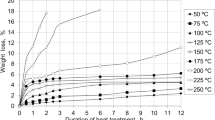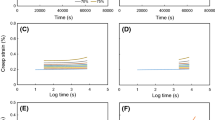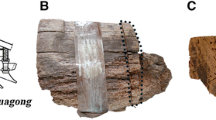Abstract
Plywood is an important wood-based construction material yet prone to water uptake, as such potentially decreasing mechanical properties and increasing decay risk. It is therefore, essential to understand the moisture behavior and structural changes of plywood in service. In this research, several plywood specimens were exposed to outdoor weathering conditions for approximately 1 year. During this period, the average moisture variation of and moisture distribution in different veneer layers of a set of plywood specimens and detailed field weather information were recorded continuously. The internal structure of the specimens was also monitored by periodically scanning using X-ray CT. Measurements indicate that moisture distribution in plywood is not homogeneous in outdoor conditions. The second layer can, in some plywood types, accumulate a significant amount of rain, and long rainy periods and cloudy weather can keep the moisture content of the inner layers of plywood significantly high. Moisture accumulation and moisture dynamics, in combination with wood species, are the main factors causing structural changes, mainly occurring as cracks, of the plywood veneers in service. The glue line between the veneers, however, is not ruptured after 1 year of outdoor exposure. Plywood with layers having a slow water sorption and fast water desorption could effectively avoid internal moisture accumulation and cracks in service. Based on the knowledge of the interrelationship of weather data, internal moisture behavior and structural changes in service, fit-for-purpose design of plywood could be improved and service life prediction is at hand.










Similar content being viewed by others
References
Antikainen T, Rohumaa A, Hunt CG, Levirinne M, Hughes M (2015) Estimating the spread rate of urea formaldehyde adhesive on birch (Betula pendula Roth) veneer using fluorescence. Eur J Wood Prod 73:69–75
Brischke C, Rapp AO, Bayerbach R (2008a) Measurement system for long-term recording of wood moisture content with internal conductively glued electrodes. Build Environ 43:1566–1574
Brischke C, Rapp AO, Bayerbach R, Morsing N, Fynholm P, Welzbacher CR (2008b) Monitoring the “material climate” of wood to predict the potential for decay: results from in situ measurements on buildings. Build Environ 43:1575–1582
Chen S, Liu X, Fang L, Wellwood R (2009) Digital X-ray analysis of density distribution characteristics of wood-based panels. Wood Sci Technol 44:85–93
De Ridder M, Van den Bulcke J, Vansteenkiste D, Van Loo D, Dierick M, Masschaele B, De Witte Y, Mannes D, Lehmann E, Beeckman H, Van Hoorebeke L, Van Acker J (2011) High-resolution proxies for wood density variations in Terminalia superba. Annu Bot 107:293–302
Drow JT (1957) Effect of moisture on the compressive, bending, and shear strengths, and on the toughness of plywood. Forest Products Laboratory, Forest Service U.S. Department of Agriculture
Evans PD, Thay PD, Schmalzl KJ (1996) Degradation of wood surfaces during natural weathering. Effects on lignin and cellulose and on the adhesion of acrylic latex primers. Wood Sci Technol 30:411–422
George T (1991) Science and technology of wood: structure, properties, utilization. Van Nostrand Reinhold, New York
Gillespie RH, River BH (1976) Durability of adhesives in plywood. For Prod J 26:21–25
Hon DNS, Feist WC (1986) Weathering characteristics of hardwood surfaces. Wood Sci Technol 20:169–183
James WL (1988) Electric moisture meters for wood. Department of Agriculture, Forest Service, Forest Products Laboratory
Kojima Y, Suzuki S (2011a) Evaluating the durability of wood-based panels using internal bond strength results from accelerated aging treatments. J Wood Sci 57:7–13
Kojima Y, Suzuki S (2011b) Evaluation of wood-based panel durability using bending properties after accelerated aging treatments. J Wood Sci 57:126–133
Kropf FW, Sell J, Feist WC (1994) Comparative weathering tests of North-American and European exterior wood finishes. For Prod J 44:33–41
Lee WC, Biblis EJ (1976) Hygroscopic properties and shrinkage of southern yellow pine plywood. Wood Fiber 8:152–158
Li WZ, Van den Bulcke J, De Windt I, Van Loo D, Dierick M, Brabant L, Van Acker J (2013) Combining electrical resistance and 3-D X-ray computed tomography for moisture distribution measurements in wood products exposed in dynamic moisture conditions. Build Environ 67:250–259
Li WZ, Van den Bulcke J, Mannes D, Lehmann E, De Windt I, Dierick M, Van Acker J (2014) Impact of internal structure on water-resistance of plywood studied using neutron radiography and X-ray tomography. Constr Build Mater 73:171–179
Lindgren LO (1991) Medical cat-scanning: X-ray absorption-coefficients, CT-numbers and their relation to wood density. Wood Sci Technol 25:341–349
Masschaele B, Dierick M, Van Loo D, Boone MN, Brabant L, Pauwels E, Cnudde V, Van Hoorebeke L (2013) Hector: A 240 kv micro-CT setup optimized for research. In: 11th international conference on X-ray microscopy, vol 463, Shanghai, China
Meyer L, Brischke C (2015) Interpretation of moisture monitoring data—relevance of moisture content thresholds for fungal decay. In: The 46th annual meeting of the international research group on wood protection. Viña del Mar Chile
Reinprecht L, Kmet’ova L (2014) Fungal resistance and physical–mechanical properties of beech plywood having durable veneers or fungicides in surfaces. Eur J Wood Prod 72:433–443
River BH (1994) Outdoor aging of wood-based panels and correlation with laboratory aging. For Prod J 44:55–65
Van Acker J, De Smet J (2007) Moisture dynamics of plywood in exterior applications as a basis for service life prediction. In: Proceedings of the international panel products symposium IPPS, Cardiff, South Wales, UK, pp 47–60
Van den Bulcke J, Van Acker J, De Smet J (2009) An experimental set-up for real-time continuous moisture measurements of plywood exposed to outdoor climate. Build Environ 44:2368–2377
Van den Bulcke J, De Windt I, Defoirdt N, De Smet J, Van Acker J (2011) Moisture dynamics and fungal susceptibility of plywood. Int Biodeterior Biodegradation 65:708–716
Viitanen HA (1997) Modelling the time factor in the development of brown rot decay in pine and spruce sapwood—the effect of critical humidity and temperature conditions. Holzforschung 51:99–106
Vlassenbroeck J, Dierick M, Masschaele B, Cnudde V, Van Hoorebeke L, Jacobs P (2007) Software tools for quantification of X-ray microtomography at the UGCT. Nucl Instrum Methods Phys Res Sect A 580:442–445
Walker JCF (1993) Primary wood processing: principles and practice. Chapman & Hall, London; New York
Williams RS (2005) Handbook of wood chemistry and wood composites. Chapter 7: weathering of wood. CRC Press LLC, Boca Raton
Acknowledgement
The authors would like to thank Mr. Rik De Rycke, Mr. Stijn Willen and Mr. Pieter Vanderniepen for their technical assistance. The author also would like to thank the fund from the China Scholarship Council (CSC) for the PhD funding granted to the first author. This research was performed in support of the European Project SILEX “Improving sustainability of construction materials using innovative silicon-based treatment”, with Project Number LIFE11 ENV/BE/1046 and DO-IT Houtbouw.
Author information
Authors and Affiliations
Corresponding author
Rights and permissions
About this article
Cite this article
Li, W., Van den Bulcke, J., De Windt, I. et al. Moisture behavior and structural changes of plywood during outdoor exposure. Eur. J. Wood Prod. 74, 211–221 (2016). https://doi.org/10.1007/s00107-015-0992-z
Received:
Published:
Issue Date:
DOI: https://doi.org/10.1007/s00107-015-0992-z




